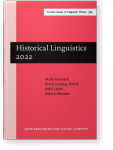Semantic factors in case loss
The Serbian-Bulgarian dialectal continuum
The South Slavic dialect continuum formed by Serbian and Bulgarian provides a fine environment to
investigate case loss. Different points on this continuum show varying degrees of case loss: standard Serbian represents a
conservative variety with six cases, and standard Bulgarian represents an innovative variety with no nominal case inflection.
The continuum between these two extremes shows a transition from larger to smaller case systems. We focus on three functions:
instrument, transport, and trajectory, which were originally conveyed by the non-prepositional instrumental, and model what
happens to them when the case form is lost. We demonstrate how they lose their original unity and are distributed over
different constructions.
Article outline
- 1.Introduction
- 2.Serbian-Bulgarian dialectal continuum
- 3.Data
- 3.1Object of study
- 3.2Sources
- 4.Meanings of instrumental
- 4.1Instrument
- 4.2Transport
- 4.3Trajectory
- 5.Conclusion
-
Notes
-
References
This content is being prepared for publication; it may be subject to changes.
